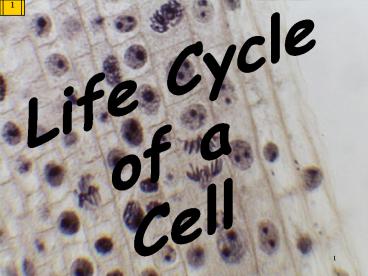Life Cycle - PowerPoint PPT Presentation
1 / 40
Title:
Life Cycle
Description:
1 Cell Size Why not just one large cell? Difficult to get nutrients in and waste out Phases of The Cell Cycle Somatic cell cycle G1 phase- Gap phase, cell undergoes ... – PowerPoint PPT presentation
Number of Views:115
Avg rating:3.0/5.0
Title: Life Cycle
1
Life Cycle of a Cell
1
2
Cell Size
2
- Why not just one large cell?
- Difficult to get nutrients in and waste out
3
Phases of The Cell Cycle
3
G1,S, and G2 are known together as Interphase.
4
Regular Cells
4
Interphase
- Somatic cell cycle
- G1 phase- Gap phase, cell undergoes growth.
- S phase- DNA synthesis
- G2 phase- Gap phase. Preparation for Mitosis.
Organelles are produced. - M phase- Cell division (Mitosis and cytokinesis)
Sex cells are called gametes
5
G1 Phase
5
- Cell grows
6
S Phase
6
- Chromosomes Condense
- Chromosomes are inherited genetic information
- Chromosomes are made up of DNA
- Can only be seen when cells are dividing
7
S Phase
7
- Chromosomes replicate-or copy is made
- The two copies are
- -attached together at a point called a
centromere. - -are called sister chromatid.
8
8
9
G2 Phase
9
- Organelles must be replicated (copied)
9
10
M Phase
10
- Two parts
- Nuclear division
- Mitosis
- Cytoplasmic Division
- Cytokinesis
10
11
Mitosis
11
- Nuclear Division.
- Nucleus divides into two new nuclei Mitosis keeps
the number of chromosomes constant from one cell
generation to the next. - In eukaryotes, it is the main process by which
growth and tissue repair is accomplished. - Mitosis is also the main process by which
single-celled and many multi-celled eukaryotes
reproduce asexually.
12
4 Steps of Mitosis (PMAT)
12
- Prophase Chromosomes condense and attach to the
spindle fibers at their centromere. - Nuclear
- Membrane
- breaks down.
13
Steps of Mitosis (PMAT)
13
- Prophase Centrioles move to opposite sides of
the cell and organize the spindle fibers
14
Metaphase Chromosomes attach to spindle
fibersand line up in the middle of the cell
14
15
Anaphase Chromosomes separate-Move to opposite
sides of the cell
15
16
Telophase
16
There are now TWO nuclei in one cell!
- Nuclear Envelope reforms
And they contain the SAME genetic
informationSAME NUMBER OF CHROMOSOMES
17
17
18
18
19
Cytokinesis
19
- Cytoplasmic division
- Each cell gets half of the organelles.
- After mitosis cell pinches in half to form two
new cells.
20
Cytokinesis
20
- Animal cells pinch.
- Cytokinesis in plant cells is different from that
in animal cells.
21
In plant cells a cell plate forms from the inside
out.
21
22
23
23
Results of Mitosis and Cytokinesis
24
- Two new cells.
- The new cells- called daughter cells- have the
same number of chromosomes as the mother cell. - This occurs in all somatic cells in your body.
- You have 46 chromosomes in all of your somatic
cells-23 pair!
24
Mitosis in Onion
25
25
26
- Cells
- during
- Mitosis
26
27
27
28
28
29
Concept Map
Cell Cycle
includes
is divided into
is divided into
29
Reproduction of Sex Cells
30
- Sex cells- Sperm and egg
- Process is called Meiosis
- Similar to Mitosis
30
Meiosis
31
- Cell divides twice
- First division is like mitosis and then the cell
divides again to create 4 haploid cells.
31
MEIOSISCHROMOSOME REDUCTION DIVISION
32
32
33
33
Meiosis
34
- Meiosis is also know as chromosome reduction
division. - Start with 46 and ends up with 23.
- Why?
- Fertilization creates the diploid condition again
Haploid
Diploid
34
35
- Sperm formation- 4 haploid sperm cells are
formed. - Egg formation-most of the cytoplasm is used in
one cell and the other three disintegrate. One
haploid egg cell is formed.
35
36
- Meiosis
- Video Clip
36
Crossing Over
37
- Sometime during meiosis the chromosomes can
exchange information - This is called Crossing Over
- Major source of genetic diversity in the species
37
38
38
Prokaryotic Cells
39
- Binary fission
- Occurs in Prokaryotic Cells
- DNA is copied and then the cell splits in half.
39
Regulation of the Cell Cycle
40
- How do cells know when to divide? When to stop
dividing? - Cyclins-proteins that regulate the cell cycle.
40
Cancer
41
- Unregulated cell growth.
- Can form masses of cells called tumors.

